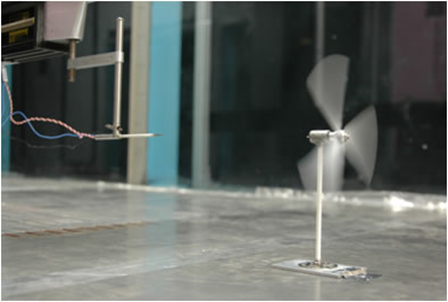Wind energy is the fastest growing source of renewable energy in the World and one of the key players in the global energy markets.Optimizing the design (turbine selection and siting) and operation of wind energy projects is currently subject to large uncertainties associated with our limited ability to predict wind and turbulence at spatial and temporal scales relevant to wind turbine operation. This is due to the complex interactions of the turbulent atmospheric boundary layer flow with wind turbines and wind farms.
At the WIRE Lab of EPFL, we use a synergistic combination of computational fluid dynamics, field experiments and wind-tunnel experiments to develop tools that can be used for the optimization of wind energy projects. Specific tasks in which the Master students will be involved include:
- Development of a Virtual Wind Simulator of atmospheric flow over complex terrain and around wind turbines and wind farms. In particular, we are developing a range of computational tools for optimizing the design (turbine siting) of wind turbines and wind farms. They range from high-resolution turbulence-resolving models (large-eddy simulations –LES, see Fig 1) to simpler analytical models. They will be validated using the wind-tunnel and field measurements described below.
- Field measurements of wind around wind turbines using LiDARs: We use a new generation of laser-based scanning LiDARs (Light, Detection and Ranging) to measure wind velocity in the atmospheric boundary layer at relatively high spatial and temporal resolutions. This information will allow us to characterize the flow around wind turbines and understand the effect on turbine performance (see Fig 2). It is also very valuable for validation of numerical models such as LES.
- Wind-tunnel experiments to optimize wind farm design. We use scaled-down wind turbine models to study the interaction between turbulent boundary layer flow (similar to the one in the atmosphere) and wind farms with different configurations and turbine densities (see Fig 3). These experiments will help us optimize the design of wind farms by maximizing energy output and minimizing fatigue loads associated with high turbulence levels.
- Wind-tunnel experiments to optimize wind-turbine siting over complex terrain. Wind tunnel experiments and numerical simulations can be used to the selection and placement of wind turbines in the landscape by modeling the effects of local topography and surface characteristics on the local flow and its interactions with the wind turbines.

Figure 1. Instantaneous simulated velocity profile obtained using large-eddy simulation with the new generation of models for turbulent fluxes and turbine-induced forces currently being developed by the WIRE Laboratory of EPFL (e.g., Wu and Porte-Agel, 2011,2012; Porte-Agel et al, 2011; Lu and Porte-Agel, 2011).

Figure 2. Wind velocity field (right) measured with two of the WIRE scanning wind lidars placed behind a wind turbine in Martigny (picture of setup on the left). These are the first measurements of their kind and will be used to validate the Wind Simulator.

Figure 3. Miniature wind turbine placed in the EPFL-WIRE turbulent boundary layer wind tunnel. Also shown is the triple wire anemometers (hot wire and cold wire) used for high-frequency measurements of velocity and temperature.
References
- W. Zhang, C. D. Markfort and F. Porté-Agel. Wind-Turbine Wakes in a Convective Boundary Layer: A Wind-Tunnel Study, Boundary-Layer Meteorology, 2012.
- Y.-T. Wu and F. Porté-Agel. Simulation of Turbulent Flow Inside and Above Wind Farms: Model Validation and Layout Effects, Boundary-Layer Meteorology, 2012.
- C.D. Markfort, W. Zhang and F. Porté-Agel. Turbulent flow and scalar transport through and over aligned and staggered wind farms, Journal of Turbulence, 2012 (In press)
- G. V. Iungo, Y.-T. Wu and F. Porté-Agel, Field measurements of wind turbine wakes with LiDARs, Journal of Atmospheric and Oceanic Technology, 2012 (Under Review)
- W. Zhang, C. D. Markfort and F. Porté-Agel. Near-wake flow structure downwind of a wind turbine in a turbulent boundary layer, Experiments in Fluids, vol. 52, num. 5, p. 1219-1235, 2012.